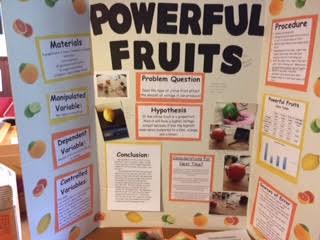Ever revert back to doing something that you once did as young student? Sure it's a loaded question so I'll explain... For Science, we were tasked with creating a science fair project to compete with 6th and 7th graders. Now

For my Science Fair Project, I decided to test the voltage of fruit. When I was first putting together the project, I needed to develop a problem question. My problem question was “Does the type of citrus fruit affect the amount of voltage it can produce?” I’ve seen the potato clocks and fruit powered clocks but I did not have enough information or knowledge to determine if fruit, or type of fruit and any effect on output of energy. My prior knowledge tells me that fruit has an acid. This acid when combined with copper and zinc, create a simple battery. Therefore, I titled my project, Powerful Fruit.
My Hypothesis was: If the citrus fruit is a grapefruit, then it will have a higher voltage output because it has the highest mass when compared to a lime, orange and a lemon. My thoughts were mass equals higher voltage output. Specifically, if a fruit weighs more in mass, I assume it has more acid in it causing to have a higher voltage output. In this case, the grapefruit had the highest mass.
In order to test the hypothesis, I had a group of three fruit from each category (orange, lemon, lime, grapefruit). Each fruit was labelled and weighed in on a scale. Copper and zinc electrodes were introduced to the fruit from each end. The electrodes cannot touch each other or they will cancel and ground the charge. Data was logged for each trial testing.
Batteries work by moving and storing charges. In order for a fruit to be a battery, it needs to be able to conduct electricity. In this case, much like a battery, you need to introduce zinc (negative terminal) and copper (positive terminal). These charged particles in the fruit acids are the same type as the charged particles in electric current. One could perhaps argue that the stronger the acid in the fruit, the more sour it will taste. Therefore another argument could be made that lemons are best suited to be a battery since they tend to be the most acidic. Since a lemon is the most sour of the three, it will make the best battery. In this case, my argument is mass is related to power output.
This can be adapted for multiple classrooms. The resources and materials are fairly inexpensive and the experiments can be endless. There are a few things to consider when using this in the classroom. Firstly, having access to a reliable voltage meter is important. The Voltage meter should be digital and capable of reading lower wattage readings. In addition, depending on the classroom, the teacher can consider using soda as well. Soda has properties when combined with zinc and copper produce an electric charge. Another idea is to blend the fruit and mix it into a slurry and add the the electrodes (older classes). Finally, like most electronic gadgets, items often use more than one battery. This is an opportunity to link the fruit together and make a ‘series’ of batteries thus increasing the voltage output. To better your results, the teacher should use lamps or LED that draw minimal wattage. Fruits tend to have very low wattage compared to voltage. The comparison between volts and watts is something that be discussed in class as well.
One last note, have the students explore the testing on their own. With enough guidance and support, this is a project that will allow students to take charge of their own knowledge and manage their own learning.

No comments:
Post a Comment